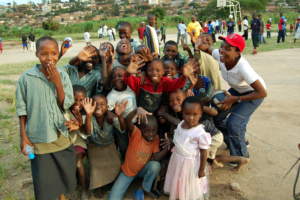Tackling Malnutrition with Sanku’s Dosifier Technology
 Food insecurity and malnutrition remain critical global issues, with 821 million people worldwide suffering. Among the most affected regions are countries like Nigeria, Somalia, Yemen and South Sudan. Malnutrition affects 52 million children under 5, with $3.6 billion needed annually to combat the issue. To combat this, Sanku is using innovative technology with fortified flour and equipping small-scale flour mills in Africa. By doing so, it is bringing essential nutrients to millions of people in some of the most vulnerable communities.
Food insecurity and malnutrition remain critical global issues, with 821 million people worldwide suffering. Among the most affected regions are countries like Nigeria, Somalia, Yemen and South Sudan. Malnutrition affects 52 million children under 5, with $3.6 billion needed annually to combat the issue. To combat this, Sanku is using innovative technology with fortified flour and equipping small-scale flour mills in Africa. By doing so, it is bringing essential nutrients to millions of people in some of the most vulnerable communities.
The Problem of Micronutrient Malnutrition
Micronutrient malnutrition, often referred to as ‘hidden hunger,’ affects 2 billion people globally. This type of malnutrition results from a lack of essential vitamins and minerals, which can lead to severe health issues. In rural communities in Africa, where poverty rates in Africa are high, nutritious food is limited. In Tanzania, 95% of the population, more than 50 million people, do not benefit from large-scale food fortification programs because they rely on small-scale mills that cannot fortify their flour. These people mainly consume maize flour. Maize flour, although calorie-dense, is nutritionally low. This, in turn, makes them susceptible to preventable diseases and increased mortality rates.
Sanku’s Innovative Dosifier
Sanku’s solution to this is its award-winning dosifier, a device designed specifically for small rural mills in East Africa. The dosifier adds precise amounts of critical nutrients such as iron, zinc, folic acid and vitamin B12 to the calorie-dense maize flour during the milling process. By partnering with local millers, the organization ensures that the fortified flour reaches those who need it most. Sanku has installed nearly 500 dosifiers across 400 mills in Tanzania and Kenya and, therefore, provides this fortified flour to 7.1 million people. The dosifier allows millers to sell the fortified flour at the same price as unfortified flour.
Leveraging IoT
To further expand its reach, Sanku had partnered with Vodafone, incorporating Internet of Things (IoT) technology into its dosifiers. This partnership allows for real-time monitoring of the fortification process, ensuring they are working effectively. With Vodafone’s IoT SIM cards, one Sanku working can now monitor 100 mills, fortifying flour for 500,000 people. This real-time data helps Sanku track maintenance needs, power supply and fortification levels remotely. Moreover, Vodafone’s mobile payment service, M-Pesa, simplifies financial transactions for millers, making it easier for them to purchase fortification premix.
Reaching Millions
Sanku’s ambition is to reach 25 million people in East Africa by 2025, ultimately preventing malnutrition-based diseases, In 2023, the organization also launched a nutrient-premix facility in Tanzania, giving it more control over its supply chain and reducing cost. Sanku’s impact extends beyond just health improvements. By providing fortified flour to vulnerable communities, the organization saves billions in GDP and helps boost productivity. In 2019, Sanku’s dosifier technology was recognized by Time Magazine as one of the top 100 inventions of 2019, highlighting its potential to transform food insecurity globally.
Vision 2030
Sanku’s long-term goal is to reach 100 million people with fortified flour by 2030. The organization is already scaling its efforts beyond Tanzania and Kenya with plans to expand into Malawi and Rwanda. With the continued support of partners like Vodafone, it is set to make a significant dent in global malnutrition. Sanku’s dosifier technology represents a breakthrough in the fight against hidden hunger by enabling small-scale mills to fortify flour with essential micronutrients. With ambitious plans to scale further and reach 100 million people by 2030, Sanku is on its way to making a lasting impact on global food security.
– Ellisha Hicken
Ellisha is based in London, UK and focuses on Technology and Solutions for The Borgen Project.
Photo: Flickr
